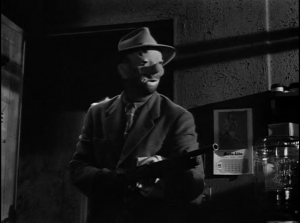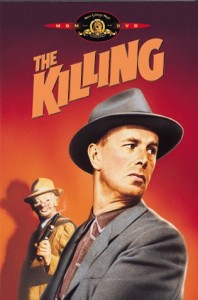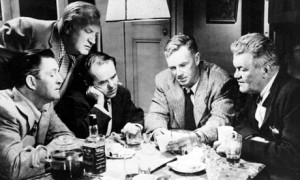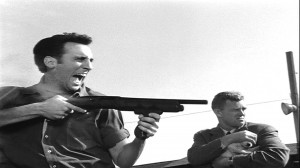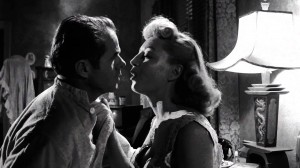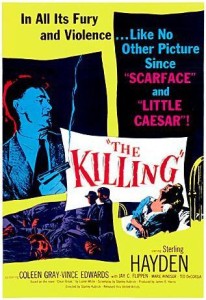The Killing ***** (1956, Sterling Hayden, Coleen Gray, Vince Edwards, Jay C Flippen, Marie Windsor, Ted de Corsia, Elisha Cook Jr, Timothy Carey) – Classic Movie Review 359
Stanley Kubrick’s exhilarating youthful 1956 masterpiece – his third feature made when he was 28 – is a taut, fast-paced, atmospheric B-movie noir thriller. It gets top mileage from its carefully delineated characters of hoods and molls and its driving plot about thieves falling out over a complex horse-racing bet takings robbery, an inside-job that goes badly wrong.
Sterling Hayden stars as an ex-con called Johnny Clay, just freed from jail and reunited with his down-home sweetheart Fay (Coleen Gray). Hayden sets about to mastermind one more, final, job – a daring, complex $2 million heist on a racetrack, unwittingly and unfortunately recruiting a bunch of doomed losers as his gang.
But, hey, the best laid plans… Spanners inevitably get into the works of the heist, thanks to Sherry Peatty (Marie Windsor), the wife of the teller George Peatty (Elisha Cook Jr) who is part of the heist, the wife’s boyfriend, airport regulations and a little dog.
The Killing is lit up by resonant performances from a tasty cast that highlights strong silent Hayden, brash femme fatale Windsor, her mousey husband Cook Jr, retired buddy Jay C Flippen, bartender Joe Sawyer, hitman Timothy Carey and cop Ted de Corsia, all combining to portray a beautifully etched rogue’s gallery.
Lucien Ballard’s stark cinematography is startling and imaginative, conjuring up perfectly the seedy petty-crook milieu and racetrack atmosphere, also captured ideally in Jim Thompson’s hard-bitten dialogue.
Kubrick dares to spend time building up character and leaves the camera facing just two characters for extended dialogue sequences, then bursts into fast movement, panning and tracking, and sudden (sometimes violent) action. Only the portentous voice-over announcing the complicated time-shifting scene setting, the odd phoney back-projection, and the irritatingly insistent score by Gerald Fried – all very much of their time – sound false notes.
But Kubrick’s non-chronological narration of the story by a time-scrambling juggling act with the sequences for interconnecting flashbacks is clever and modern, allowing him to examine the processes of planning, robbery and aftermath out of sequence with no fat and no loss of comprehension.
Above all, the ultra-meticulous, painstaking Kubrick gets the detail right in a film that’s stylised and set-bound, yet documentary-like and always believable.
Much admired and imitated, this seminal movie is an influence on Reservoir Dogs. Kubrick and Thompson wrote their hard-boiled screenplay adapted from Lionel White’s pulp novel Clean Break.
© Derek Winnert 2013 Classic Movie Review 359
Check out more reviews on http://derekwinnert.com


